猝死病例讨论
- 格式:ppt
- 大小:768.50 KB
- 文档页数:30
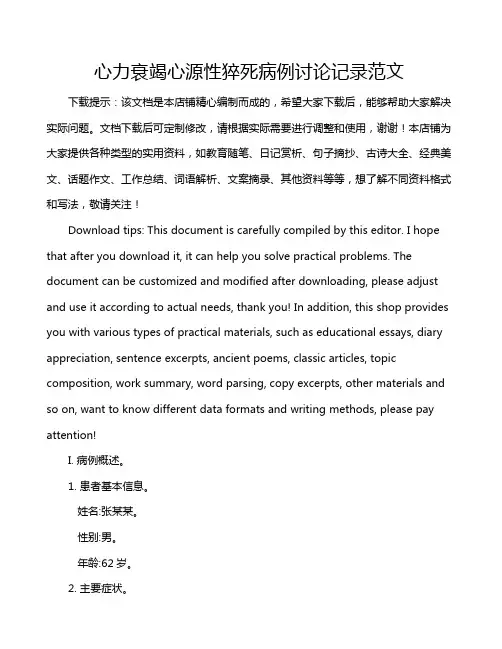
心力衰竭心源性猝死病例讨论记录范文下载提示:该文档是本店铺精心编制而成的,希望大家下载后,能够帮助大家解决实际问题。
文档下载后可定制修改,请根据实际需要进行调整和使用,谢谢!本店铺为大家提供各种类型的实用资料,如教育随笔、日记赏析、句子摘抄、古诗大全、经典美文、话题作文、工作总结、词语解析、文案摘录、其他资料等等,想了解不同资料格式和写法,敬请关注!Download tips: This document is carefully compiled by this editor. I hope that after you download it, it can help you solve practical problems. The document can be customized and modified after downloading, please adjust and use it according to actual needs, thank you! In addition, this shop provides you with various types of practical materials, such as educational essays, diary appreciation, sentence excerpts, ancient poems, classic articles, topic composition, work summary, word parsing, copy excerpts, other materials and so on, want to know different data formats and writing methods, please pay attention!I. 病例概述。
1. 患者基本信息。
姓名:张某某。
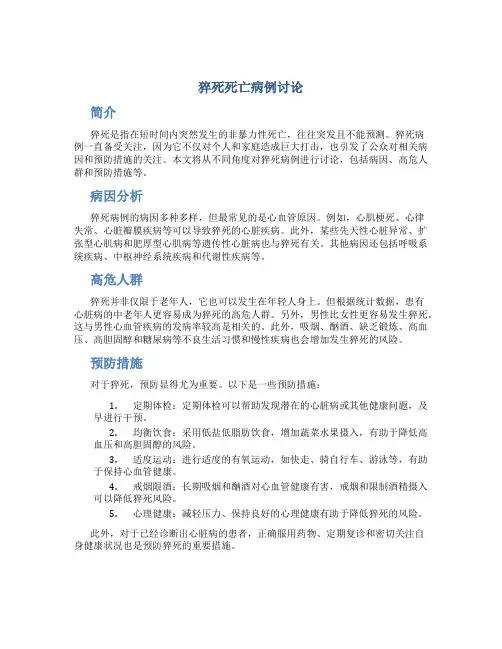
猝死死亡病例讨论简介猝死是指在短时间内突然发生的非暴力性死亡,往往突发且不能预测。
猝死病例一直备受关注,因为它不仅对个人和家庭造成巨大打击,也引发了公众对相关病因和预防措施的关注。
本文将从不同角度对猝死病例进行讨论,包括病因、高危人群和预防措施等。
病因分析猝死病例的病因多种多样,但最常见的是心血管原因。
例如,心肌梗死、心律失常、心脏瓣膜疾病等可以导致猝死的心脏疾病。
此外,某些先天性心脏异常、扩张型心肌病和肥厚型心肌病等遗传性心脏病也与猝死有关。
其他病因还包括呼吸系统疾病、中枢神经系统疾病和代谢性疾病等。
高危人群猝死并非仅限于老年人,它也可以发生在年轻人身上。
但根据统计数据,患有心脏病的中老年人更容易成为猝死的高危人群。
另外,男性比女性更容易发生猝死。
这与男性心血管疾病的发病率较高是相关的。
此外,吸烟、酗酒、缺乏锻炼、高血压、高胆固醇和糖尿病等不良生活习惯和慢性疾病也会增加发生猝死的风险。
预防措施对于猝死,预防显得尤为重要。
以下是一些预防措施:1.定期体检:定期体检可以帮助发现潜在的心脏病或其他健康问题,及早进行干预。
2.均衡饮食:采用低盐低脂肪饮食,增加蔬菜水果摄入,有助于降低高血压和高胆固醇的风险。
3.适度运动:进行适度的有氧运动,如快走、骑自行车、游泳等,有助于保持心血管健康。
4.戒烟限酒:长期吸烟和酗酒对心血管健康有害,戒烟和限制酒精摄入可以降低猝死风险。
5.心理健康:减轻压力、保持良好的心理健康有助于降低猝死的风险。
此外,对于已经诊断出心脏病的患者,正确服用药物、定期复诊和密切关注自身健康状况也是预防猝死的重要措施。
总结猝死是一种突发且无法预测的非暴力性死亡,多与心血管疾病有关。
猝死风险存在于各个年龄层次和性别,但中老年男性由于心血管疾病的高发病率更易受到影响。
通过定期体检、均衡饮食、适度运动、戒烟限酒和维护心理健康等预防措施,可以降低猝死的风险。
对已经诊断出心脏病的患者来说,密切关注自身健康状况也是必不可少的。

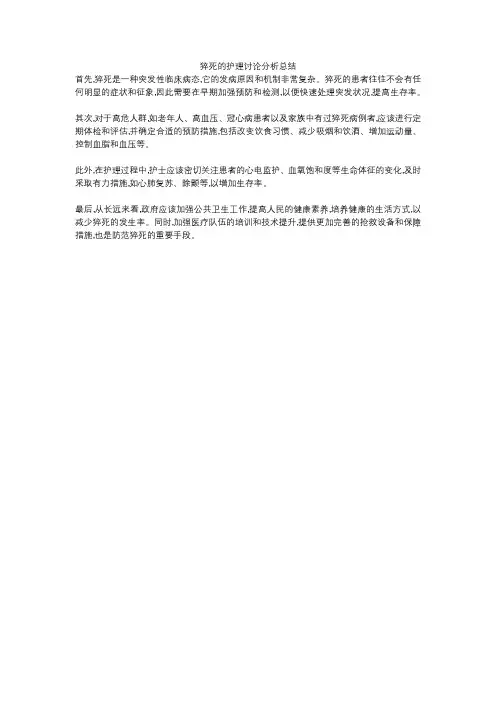
猝死的护理讨论分析总结
首先,猝死是一种突发性临床病态,它的发病原因和机制非常复杂。
猝死的患者往往不会有任何明显的症状和征象,因此需要在早期加强预防和检测,以便快速处理突发状况,提高生存率。
其次,对于高危人群,如老年人、高血压、冠心病患者以及家族中有过猝死病例者,应该进行定期体检和评估,并确定合适的预防措施,包括改变饮食习惯、减少吸烟和饮酒、增加运动量、控制血脂和血压等。
此外,在护理过程中,护士应该密切关注患者的心电监护、血氧饱和度等生命体征的变化,及时采取有力措施,如心肺复苏、除颤等,以增加生存率。
最后,从长远来看,政府应该加强公共卫生工作,提高人民的健康素养,培养健康的生活方式,以减少猝死的发生率。
同时,加强医疗队伍的培训和技术提升,提供更加完善的抢救设备和保障措施,也是防范猝死的重要手段。
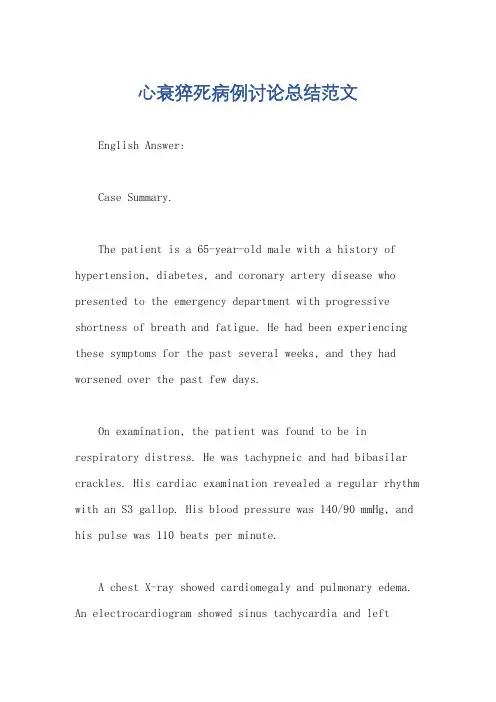
心衰猝死病例讨论总结范文English Answer:Case Summary.The patient is a 65-year-old male with a history of hypertension, diabetes, and coronary artery disease who presented to the emergency department with progressive shortness of breath and fatigue. He had been experiencing these symptoms for the past several weeks, and they had worsened over the past few days.On examination, the patient was found to be in respiratory distress. He was tachypneic and had bibasilar crackles. His cardiac examination revealed a regular rhythm with an S3 gallop. His blood pressure was 140/90 mmHg, and his pulse was 110 beats per minute.A chest X-ray showed cardiomegaly and pulmonary edema. An electrocardiogram showed sinus tachycardia and leftventricular hypertrophy. A transthoracic echocardiogram showed a dilated left ventricle with an ejection fractionof 25%.The patient was diagnosed with heart failure and was started on treatment with diuretics, ACE inhibitors, and beta-blockers. He was also given oxygen therapy.Discussion.Heart failure is a condition in which the heart is unable to pump enough blood to meet the body's needs. This can lead to a number of symptoms, including shortness of breath, fatigue, and swelling in the legs. Heart failure is a serious condition, and it can lead to death if it is not treated.There are a number of different causes of heart failure. In the patient's case, his heart failure was likely due to his history of hypertension, diabetes, and coronary artery disease. These conditions can all damage the heart muscle and lead to heart failure.The treatment of heart failure depends on the underlying cause. In the patient's case, his treatment included diuretics, ACE inhibitors, and beta-blockers. These medications can help to improve the heart's function and reduce the symptoms of heart failure.Conclusion.Heart failure is a serious condition, but it can be treated. If you have any of the symptoms of heart failure, it is important to see your doctor right away.Chinese Answer:病例总结。
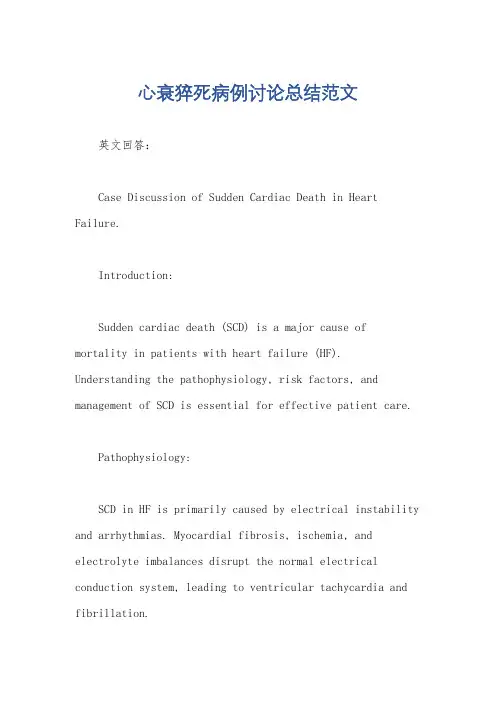
心衰猝死病例讨论总结范文英文回答:Case Discussion of Sudden Cardiac Death in Heart Failure.Introduction:Sudden cardiac death (SCD) is a major cause ofmortality in patients with heart failure (HF). Understanding the pathophysiology, risk factors, and management of SCD is essential for effective patient care.Pathophysiology:SCD in HF is primarily caused by electrical instability and arrhythmias. Myocardial fibrosis, ischemia, and electrolyte imbalances disrupt the normal electrical conduction system, leading to ventricular tachycardia and fibrillation.Risk Factors:The following factors increase the risk of SCD in HF:Low left ventricular ejection fraction (LVEF)。
History of ventricular arrhythmias.Electrocardiographic abnormalities (e.g., QRS prolongation, bundle branch block)。
New York Heart Association (NYHA) class III-IV symptoms.Diabetes.Renal dysfunction.Metabolic abnormalities.Management:The management of SCD in HF aims to reduce arrhythmic events and improve survival. Strategies include:Medications: Beta-blockers, angiotensin-converting enzyme inhibitors (ACEIs), and aldosterone antagonists have been shown to reduce arrhythmias and improve LVEF.Implantable cardioverter-defibrillator (ICD): ICDs are devices that detect and terminate life-threatening arrhythmias. They are recommended for patients at high risk of SCD.Cardiac resynchronization therapy (CRT): CRT improves electrical conduction and ventricular function, reducing arrhythmias and improving symptoms.Lifestyle modifications: Smoking cessation, regular exercise, and weight management can reduce cardiovascular risk factors and improve outcomes.Case Discussion:A 65-year-old male with a history of ischemic cardiomyopathy and HF presented to the emergency department with sudden collapse. He had no preceding symptoms. Examination revealed hypotension, tachycardia, and absent pulses. Resuscitation attempts were unsuccessful.Autopsy Findings:Autopsy revealed severe coronary artery disease and myocardial fibrosis. The left ventricle was severelydilated and had an LVEF of 15%. There was no evidence of acute myocardial infarction.Discussion:This case illustrates the devastating consequences of SCD in HF. Despite the absence of overt symptoms, the patient's underlying electrical instability and high-risk profile made him susceptible to a fatal arrhythmic event.Conclusion:SCD is a major concern in HF. Early identification of high-risk patients and timely implementation of evidence-based interventions are crucial for reducing mortality and improving patient outcomes.中文回答:心衰猝死病例讨论小结。
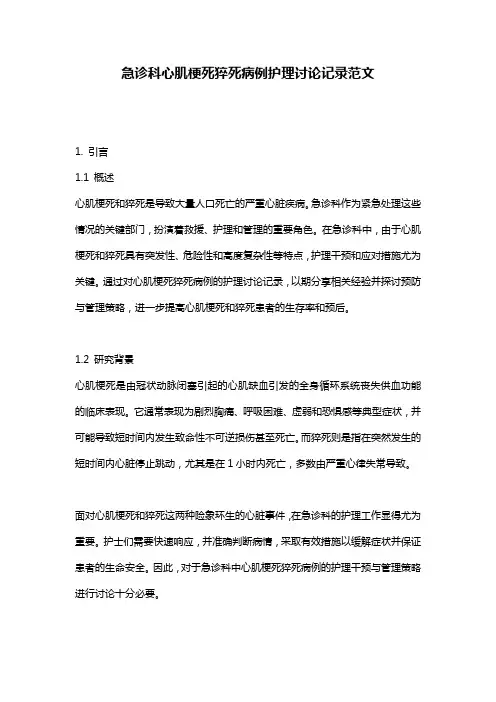
急诊科心肌梗死猝死病例护理讨论记录范文1. 引言1.1 概述心肌梗死和猝死是导致大量人口死亡的严重心脏疾病。
急诊科作为紧急处理这些情况的关键部门,扮演着救援、护理和管理的重要角色。
在急诊科中,由于心肌梗死和猝死具有突发性、危险性和高度复杂性等特点,护理干预和应对措施尤为关键。
通过对心肌梗死猝死病例的护理讨论记录,以期分享相关经验并探讨预防与管理策略,进一步提高心肌梗死和猝死患者的生存率和预后。
1.2 研究背景心肌梗死是由冠状动脉闭塞引起的心肌缺血引发的全身循环系统丧失供血功能的临床表现。
它通常表现为剧烈胸痛、呼吸困难、虚弱和恐惧感等典型症状,并可能导致短时间内发生致命性不可逆损伤甚至死亡。
而猝死则是指在突然发生的短时间内心脏停止跳动,尤其是在1小时内死亡,多数由严重心律失常导致。
面对心肌梗死和猝死这两种险象环生的心脏事件,在急诊科的护理工作显得尤为重要。
护士们需要快速响应,并准确判断病情,采取有效措施以缓解症状并保证患者的生命安全。
因此,对于急诊科中心肌梗死猝死病例的护理干预与管理策略进行讨论十分必要。
1.3 研究意义本文旨在通过分析急诊科中心肌梗死猝死患者的个例,并通过总结护理干预和医护团队配合的经验与策略,进一步提供有助于改善急诊科中护理质量、提高患者救治效果的参考依据。
在实践层面上,通过提供相关知识和经验分享,可以帮助急诊科护士更好地应对紧急情况、提高护理水平,为患者提供更加优质的医疗服务。
此外,我相信通过对心肌梗死猝死预防与管理策略的探讨和评估,我们可以发现一些不足之处并寻求改进的方法,以逐步完善相关的护理流程和规范。
总而言之,本文对急诊科中心肌梗死猝死病例的护理进行了深度分析和讨论,并提出了预防与管理策略。
希望能够促进急诊科护士对于该类情况的处理能力,在降低心肌梗死和猝死患者发生率的同时,最大限度地保证他们的生命安全。
2. 心肌梗死猝死的定义和病因2.1 心肌梗死的定义心肌梗死(Myocardial Infarction,MI)指心脏冠状动脉供血不足或阻塞导致心肌缺血、缺氧、坏死的一种严重心脏疾病。
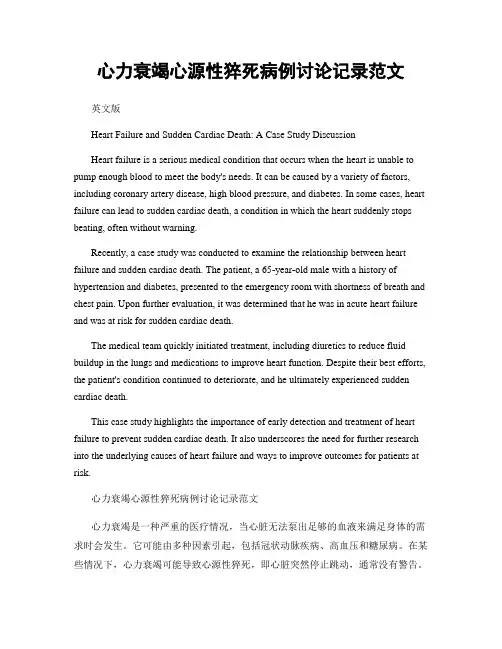
心力衰竭心源性猝死病例讨论记录范文英文版Heart Failure and Sudden Cardiac Death: A Case Study DiscussionHeart failure is a serious medical condition that occurs when the heart is unable to pump enough blood to meet the body's needs. It can be caused by a variety of factors, including coronary artery disease, high blood pressure, and diabetes. In some cases, heart failure can lead to sudden cardiac death, a condition in which the heart suddenly stops beating, often without warning.Recently, a case study was conducted to examine the relationship between heart failure and sudden cardiac death. The patient, a 65-year-old male with a history of hypertension and diabetes, presented to the emergency room with shortness of breath and chest pain. Upon further evaluation, it was determined that he was in acute heart failure and was at risk for sudden cardiac death.The medical team quickly initiated treatment, including diuretics to reduce fluid buildup in the lungs and medications to improve heart function. Despite their best efforts, the patient's condition continued to deteriorate, and he ultimately experienced sudden cardiac death.This case study highlights the importance of early detection and treatment of heart failure to prevent sudden cardiac death. It also underscores the need for further research into the underlying causes of heart failure and ways to improve outcomes for patients at risk.心力衰竭心源性猝死病例讨论记录范文心力衰竭是一种严重的医疗情况,当心脏无法泵出足够的血液来满足身体的需求时会发生。
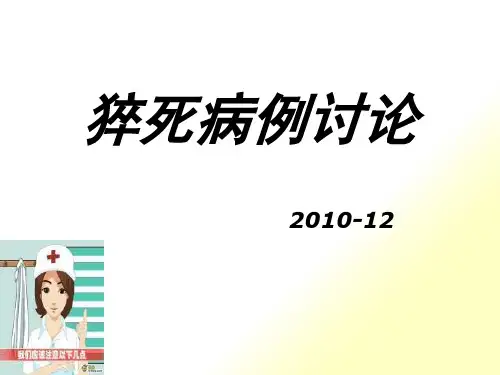

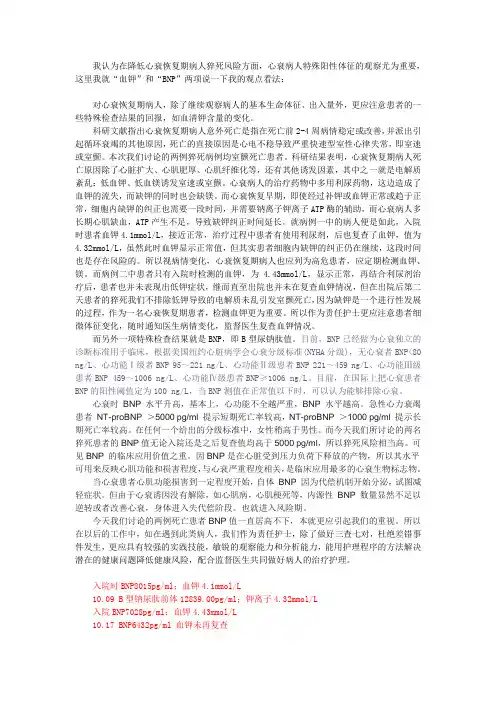
我认为在降低心衰恢复期病人猝死风险方面,心衰病人特殊阳性体征的观察尤为重要,这里我就“血钾”和“BNP”两项说一下我的观点看法:对心衰恢复期病人,除了继续观察病人的基本生命体征、出入量外,更应注意患者的一些特殊检查结果的回报,如血清钾含量的变化。
科研文献指出心衰恢复期病人意外死亡是指在死亡前2-4周病情稳定或改善,并派出引起循环衰竭的其他原因,死亡的直接原因是心电不稳导致严重快速型室性心律失常,即室速或室颤。
本次我们讨论的两例猝死病例均室颤死亡患者。
科研结果表明,心衰恢复期病人死亡原因除了心脏扩大、心肌肥厚、心肌纤维化等,还有其他诱发因素,其中之一就是电解质紊乱:低血钾、低血镁诱发室速或室颤。
心衰病人的治疗药物中多用利尿药物,这边造成了血钾的流失,而缺钾的同时也会缺镁。
而心衰恢复早期,即使经过补钾或血钾正常或趋于正常,细胞内缺钾的纠正也需要一段时间,并需要钠离子钾离子ATP酶的辅助,而心衰病人多长期心肌缺血,ATP产生不足,导致缺钾纠正时间延长。
就病例一中的病人便是如此,入院时患者血钾4.1mmol/L,接近正常,治疗过程中患者有使用利尿剂,后也复查了血钾,值为4.32mmol/L,虽然此时血钾显示正常值,但其实患者细胞内缺钾的纠正仍在继续,这段时间也是存在风险的。
所以视病情变化,心衰恢复期病人也应列为高危患者,应定期检测血钾、镁。
而病例二中患者只有入院时检测的血钾,为 4.43mmol/L,显示正常,再结合利尿剂治疗后,患者也并未表现出低钾症状,继而直至出院也并未在复查血钾情况,但在出院后第二天患者的猝死我们不排除低钾导致的电解质未乱引发室颤死亡,因为缺钾是一个进行性发展的过程,作为一名心衰恢复期患者,检测血钾更为重要。
所以作为责任护士更应注意患者细微体征变化,随时通知医生病情变化,监督医生复查血钾情况。
而另外一项特殊检查结果就是BNP,即B型尿钠肽值。
目前,BNP已经做为心衰独立的诊断标准用于临床,根据美国纽约心脏病学会心衰分级标准(NYHA分级),无心衰者BNP<80 ng/L、心功能Ⅰ级者BNP 95~221 ng/L、心功能Ⅱ级患者BNP 221~459 ng/L、心功能Ⅲ级患者BNP 459~1006 ng/L、心功能Ⅳ级患者BNP≥1006 ng/L。
心源性猝死的病例分析与讨论猝死是指在短时间内发生的突然停止心跳和呼吸的现象,临床上非常危急。
其中,心源性猝死指由于心脏病导致的猝死事件。
本文将通过一个实际病例分析与讨论心源性猝死的相关信息,以期增加对该病症的了解。
病例描述:患者为一名62岁的男性,此前无明显心脏病疾病,无家族史。
猝死事件发生在患者午餐后不久,在其家中突然昏倒,并失去意识。
紧急救护人员接到报警后迅速赶到现场,进行了心肺复苏,但最终未能挽回患者的生命。
病例分析与讨论:1. 猝死的病因分析:心源性猝死的主要病因通常是冠心病。
冠心病是指冠状动脉供血不足引起的心肌缺血、心肌梗死等心血管疾病。
在该病例中,由于患者此前无明显心脏病症状,并且无家族史,我们推测患者可能是突发性的、广泛的心肌梗死所导致的猝死。
2. 危险因素的分析:心源性猝死的发生与众多危险因素相关。
常见的危险因素包括高龄、阳性家族史、吸烟、高血压、高胆固醇、肥胖、糖尿病和缺乏运动等。
然而,在该病例中,患者年龄并不算大,无家族史,从临床资料来看,并无其他明显的危险因素。
3. 诊断与预防:心源性猝死的诊断往往是根据患者临床症状、体征和心电图等方面综合进行的。
然而,在该病例中,患者此前并无心脏症状,令人遗憾的是他未能获得诊断和治疗机会。
对于类似的患者,我们应该加强对于心脏疾病的早期筛查,包括定期体检、心脏超声检查、血液检测等,以便尽早发现和干预潜在的心脏疾病。
4. 急救与复苏措施:快速而正确的急救措施对于心源性猝死患者而言至关重要。
常见的急救措施包括立即拨打急救电话、进行心肺复苏(CPR)、使用自动体外除颤仪(AED)等。
在该病例中,紧急救护人员迅速到达现场,并进行了CPR,但最终未能使患者恢复呼吸和心跳。
这也再次强调了对于心源性猝死患者的急救手段必须快速和准确。
结论:心源性猝死是一种突发且危险的疾病,可导致患者生命的丧失。
尽管在该病例中患者最终未能幸免于难,但通过这个病例,我们再次意识到了对于心脏疾病早期筛查、正确急救措施和科学预防的重要性。
猝死死亡病例讨论模板猝死是指人在没有明显疾病表现的情况下,突然死亡的现象。
猝死的发生在世界各地都存在,并且不分年龄、性别和职业。
对于猝死的原因和预防措施,一直是医学界和公众关注的焦点。
本文将探讨猝死案例,并给出相关参考内容。
猝死案例的讨论和研究是为了进一步了解猝死的原因和预防方法,以减少猝死的发生。
以下是一些猝死案例的相关参考内容:1. 病史与症状:猝死的个案通常会描绘猝死者的病史和症状,包括是否有心脏疾病、高血压、糖尿病等基础疾病,并记录在猝死现场是否有异常发现。
这些信息有助于诊断原因和制定预防措施。
2. 高危因素:猝死个案中的高危因素是值得关注的。
例如,大量的研究表明吸烟、高脂饮食、久坐不动等不良生活习惯与猝死风险增加相关。
此外,家族病史、高龄、肥胖等也是猝死的高危因素。
3. 器质性病变:一些猝死案例中,尸检结果显示心脏病变、动脉硬化、心肌病等病理性病变。
这些病变可以是猝死的原因或导致猝死的风险因素。
4. 预警标志:一些研究表明,猝死前往往有一些预警标志出现,如恶心、呕吐、胸闷、胸痛、心悸等症状。
如果公众能够及早认识到这些预警标志,并及时寻求医疗帮助,或许可以减少猝死的发生。
5. 心肺复苏和AED使用:在猝死案例中,心肺复苏和自动体外除颤器(AED)的使用是非常重要的。
了解正确的急救操作,并普及心肺复苏培训和AED设备的使用,可以增加猝死患者的存活率。
6. 预防措施:根据猝死案例和相关研究,一些预防措施是可以采取的。
例如,良好的饮食习惯、适量运动、戒烟限酒、保持正常体重等都可以降低患猝死的风险。
此外,定期体检、了解家族病史、控制血压、血糖和血脂等也是重要的预防措施。
猝死的发生对患者及其家人和社会产生了很大的伤害和影响。
通过分析猝死案例并采取相应的预防措施,可以提高对猝死的认识,减少猝死的发生。
希望通过这些理论基础和实践案例的讨论,能够引起公众对猝死的重视,保护自己和他人的生命安全。
心源性猝死的典型病例分析猝死是指突然发生的非外伤性因素导致的死亡事件,其中心源性猝死是最常见的一种类型。
心源性猝死是由于心血管疾病导致的心脏突然停止跳动引起的。
本文将分析一个典型的心源性猝死病例,以期加深对该疾病的理解。
该病例涉及一个45岁的男性患者,称为Mr. X。
以下是对他的典型病例的详细分析:病例回顾:Mr. X是一名经常加班的白领工作者,最近几个月一直感觉疲劳和精神压力。
他还患有高血压和高血脂症,但长期未接受治疗。
突然的心脏骤停发生在一个晚上,他正在家中休息。
他的妻子立即向急救人员求助,但不幸的是,当他们到达时,Mr. X已经停止呼吸,并宣布死亡。
分析与讨论:1. 心血管疾病风险因素:Mr. X存在多个心血管疾病的危险因素,其中包括高血压和高血脂症。
这些因素增加了他发生心脏事件的风险。
2. 高血压的影响:高血压是心源性猝死的重要风险因素之一。
未治疗的高血压导致了心脏和血管的长期负担,容易引发心脏病变,增加猝死的风险。
3. 高血脂症的影响:高血脂症是心血管疾病的另一个常见风险因素。
血液中的高胆固醇水平可以导致动脉粥样硬化,进而阻塞冠状动脉,引发心肌缺血甚至心肌梗死,从而导致心源性猝死。
4. 生活方式和心脏事件的关系:Mr. X的高强度工作和长期的压力暴露可能对他的心脏健康产生了负面影响。
长时间的工作压力和缺乏适当的休息和康复时间,可能加重了他已经存在的危险因素。
5. 生活习惯与心源性猝死的关系:调查发现,Mr. X曾长期抽烟和滥用酒精。
这些不健康的生活习惯直接提高了心脏病发作和心源性猝死的风险。
结论:通过对这个典型的心源性猝死病例的分析,我们可以看到心血管疾病的多种危险因素对猝死的发生起到了重要的作用。
尤其是未治疗的高血压和高血脂症,以及不健康的生活方式,如吸烟和酗酒,都会加重猝死的风险。
因此,预防心源性猝死的关键在于控制这些危险因素,并采取健康的生活方式。
注:本文为口述内容改编而成,以使读者更易于理解和吸收所述信息。
心源性猝死的病例分析与治疗方案心源性猝死是指由于突发的心脏原因导致患者在短时间内出现晕厥、心脏停跳等症状,最终导致死亡。
这是一种突发且危急的疾病,给患者的家属和医务人员带来了巨大的冲击。
本文将通过分析心源性猝死的一个病例,探讨其病因和治疗方案,以期提高对心源性猝死的认识和应对能力。
病例描述:患者,男性,45岁,无基础疾病,突发心脏骤停,被家人紧急送往医院。
患者在抵达医院时已经处于无意识状态,出现呼吸急促和心音消失的情况。
立即进行心肺复苏术,同时给予氧气吸入以及应用自动体外除颤仪进行除颤。
但是经过全力抢救30分钟后仍未能使患者恢复自主心跳,最终宣告抢救无效,确认病人死亡。
病因分析:心源性猝死的病因复杂,包括缺血性心脏病、心肌病、先天性心脏病、心律失常等。
本病例中,患者无基础疾病,因此我们可以排除一些遗传性的病因。
考虑到其突发性、快速恶化的情况,最有可能的病因为急性冠状动脉综合征,即急性心肌梗死。
治疗方案:1. 心肺复苏术:对于出现心脏骤停的患者,立即进行心肺复苏术是最重要的抢救措施。
应保持患者呼吸道通畅,进行胸外按压和人工呼吸,以维持血液循环。
2. 除颤治疗:自动体外除颤仪是心源性猝死患者抢救中的关键工具。
通过送电除颤,恢复正常的心律,提高抢救成功率。
3. 快速介入治疗:对于猝死病例中怀疑为急性冠状动脉综合征的患者,应尽快进行冠脉造影和介入治疗。
冠脉造影可以明确病变的部位和程度,并通过支架植入等方式恢复血流通畅。
4. 药物治疗:对于怀疑为急性心肌梗死引起的心源性猝死患者,在快速介入治疗前可以口服硝酸甘油或静脉注射阿司匹林等药物,以缓解症状和改善微循环。
5. 异位起搏治疗:部分心源性猝死患者可能出现严重的心律失常,如心室颤动等。
在医院或急救车上配备有心电生理设备的情况下,立即进行异位起搏治疗,以恢复正常心律。
病例分析总结:本病例中的患者在突发心脏骤停后经过全力抢救30分钟无效最终死亡。
根据患者无基础疾病的情况以及病情突发的特点,我们推测其最有可能的病因为急性冠状动脉综合征。